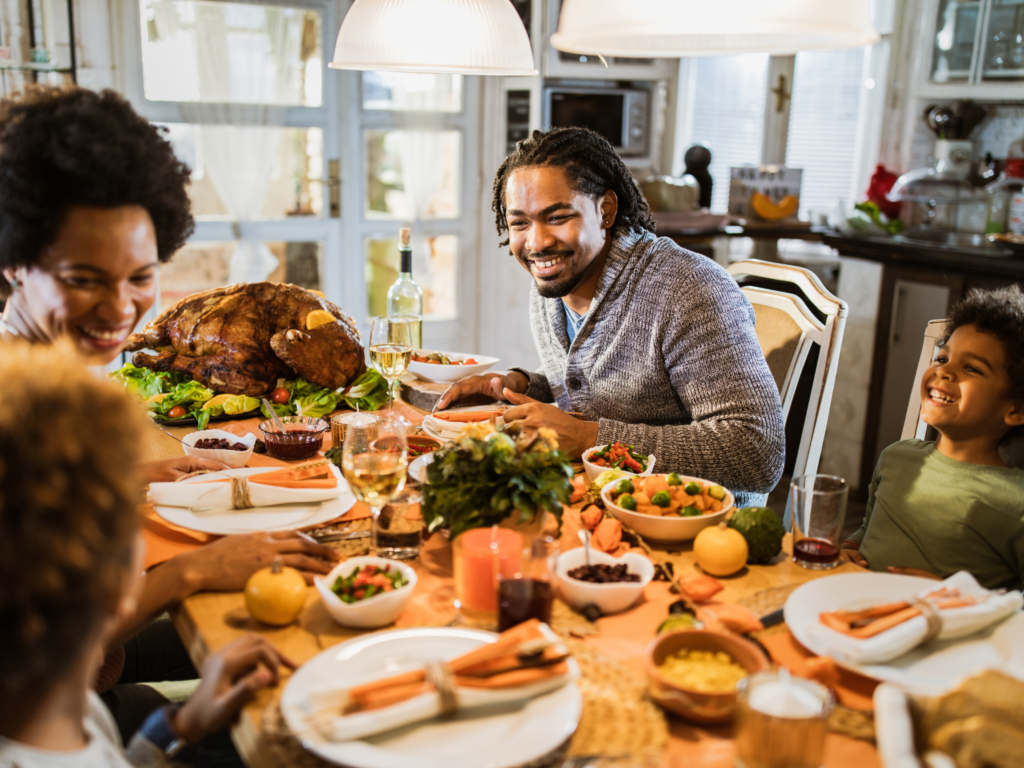Unveiling the Importance of Family Meals
Imagine a table set with steaming dishes, chairs pulled close, and the air filled with laughter and the murmur of shared stories. This is more than just a meal—it’s a tapestry of interaction and connection that has been woven into human history since time immemorial. Despite the relentless pace of modern life, the tradition of gathering around the dinner table endures, a testament to its lasting value.
Family meals, a seemingly simple routine, are actually a complex ritual steeped in significance. They are the heartbeat of family life, a daily reunion that offers far more than just sustenance. As we delve into the rich layers of family dining, we uncover a multitude of benefits: nutritional, psychological, and social. It’s where children learn the art of conversation, where teens find a listening ear, and where adults find respite from the daily grind.
Yet, in our fast-paced world, the family meal is often endangered, threatened by the demands of work schedules, extracurricular activities, and the lure of individual screens. In this blog post, we’ll explore the undeniable importance of family meals, not just as a nostalgic nod to the past but as a vital ingredient for our future well-being. Join me at the table as we savor the reasons why breaking bread together is a tradition worth preserving.
Historical Perspective
The tradition of family meals is as old as the concept of family itself, a universal ritual that transcends time and culture. Our ancestors understood the value of coming together to eat, using this time not only to nourish their bodies but to strengthen their bonds and pass on traditions. In many cultures, the family meal is a sacred space, reserved for the sharing of food, stories, and wisdom.
The Ancient Roots:
Long before the advent of modern dining conventions, ancient civilizations understood the importance of communal eating. For the Greeks and Romans, mealtime was an integral part of social and political life, serving as a forum for discourse and decision-making. In these societies, banquets, and feasts were events where not only food but also ideas were exchanged, and the foundations of democracy and philosophy were strengthened over shared platters.
Greek Symposia:
- The Greeks had a tradition known as the ‘symposium,’ a gathering that followed the evening meal, where men would discuss philosophical, political, and cultural issues while enjoying wine.
- These symposia were not merely social events; they were critical for shaping the intellectual landscape, cementing relationships, and fostering the democratic process.
Roman Convivia:
- In ancient Rome, the ‘convivium’ was a similar social gathering, where the elite would convene to solidify social bonds, engage in intellectual debate, and display their wealth through elaborate meals.
- These gatherings were meticulously structured, with the host directing the conversation and the order of events, emphasizing the significance of hierarchy and order within Roman culture.
Cultural Traditions and Rituals:
- Across different cultures, the act of coming together to eat has always been laden with ritual and significance. For instance, in traditional Chinese dining, the arrangement of seating and the order of serving dishes are deeply symbolic, reflecting respect for hierarchy and social etiquette.
- In many Middle Eastern cultures, sharing a meal is a sign of hospitality and trust, often accompanied by age-old customs like hand-washing ceremonies before sitting down to eat.
The Continuity of Commensality:
- Whether it was the Greeks or Romans, the Chinese, or the Middle Eastern communities, the common thread was the use of mealtime as a platform to foster community ties, forge alliances, and navigate the social or political climate.
- These meals were more than just about the food; they were choreographed dances of social interaction that defined relationships, status, and the very fabric of society.
The ancient roots of family meals remind us that the act of breaking bread together has always been a cornerstone of civilization. It’s a practice that nourishes not only the body but also the community and the mind, laying the groundwork for some of the most important aspects of human culture and society.
In understanding the historical context of family meals, we can better appreciate their importance and the need to preserve this tradition in modern times. As we move forward, it’s crucial to adapt while maintaining the essence of what makes family meals truly invaluable: connection, communication, and community.

The Modern-Day Dilemma: Importance of Family Meals
In the tapestry of today’s fast-paced society, the tradition of family meals faces new and complex challenges. The synchronicity of family schedules has given way to a cacophony of individual commitments, with work, education, and extracurricular activities pulling members in different directions. The result is a jigsaw puzzle of time slots that rarely align to allow for communal dining.
Schedules and Time Constraints:
- The 9-to-5 workday is no longer standard; flexible hours, shift work, and the gig economy have disrupted the collective rhythm of family life.
- Children and teenagers are equally entangled in a web of after-school programs, sports, and social events, making a shared mealtime a logistical challenge.
The Invasion of Technology:
- Digital devices have become ubiquitous companions at the dining table, diverting attention from conversation and connection to screens and virtual interactions.
- The presence of smartphones, tablets, and even televisions during meals can fragment the focus, making it difficult for family members to engage with one another meaningfully.
The Erosion of Culinary Skills:
- As the fast food industry thrives and meal delivery services grow, the art of cooking is waning in many households.
- The loss of cooking skills among younger generations, often due to the lack of transmission from parent to child, threatens the very act of meal preparation, a foundational element of the family meal.
Potential Consequences:
- The cumulative effect of these challenges risks reducing the family meal to an anachronism, a relic of past generations that is spoken of wistfully but seldom practiced.
- As the frequency of family meals diminishes, so too may the benefits they bestow—nutritional balance, emotional support, and social cohesion are at stake.
Let’s turn the page from the challenges we face and look toward the solutions and sustenance that family meals can offer us.
Nutritional Benefits
When families dine together, the table becomes more than just a surface to hold plates and cutlery; it transforms into a platform for nurturing health and well-being. The nutritional advantages of family meals are manifold and extend beyond the mere intake of vitamins and minerals.
Balanced Meals:
- Family meals often result in more balanced, diverse, and nutritious eating patterns. Parents tend to prepare meals with a variety of food groups in mind, aiming for a colorful palette of vegetables, lean proteins, whole grains, and fruits.
There are several studies that highlight the impact of family meals on the likelihood of consuming healthier foods and the reduced tendency to indulge in processed or high-calorie alternatives:
- Association with Favorable Dietary Patterns: “Cross-sectional research provides relatively strong evidence that shared family meals are associated with favorable dietary patterns among children and adolescents, including increased consumption of fruits, vegetables, and healthful nutrients.”
- Meta-Analysis on Family Meal Frequency: “A meta-analysis by Hammons and Fiese concluded that a higher frequency of family meals contributes to a reduced likelihood of unhealthy eating and a greater likelihood of healthy eating among children and adolescents.”
- Impact on Nutritional Health: “It has been suggested that clinicians advise patients about the benefits of sharing three or more family mealtimes per week. The benefits noted include a reduction in the odds for overweight by 12%, eating unhealthy foods by 20%, and disordered eating by 35%, along with an increase in the odds of eating healthy foods by 24%.”
These studies suggest that the simple act of sharing meals as a family can have significant positive effects on dietary choices and overall nutritional health.
Healthy Habits for Children: Importance of Family Meals
The dining table does more than just hold food; it serves as a classroom where lifelong eating habits are formed. The rituals and routines established during family meals play an essential role in laying down the foundation for children’s nutritional preferences and behaviors.
Role Modeling:
- Family meals offer a powerful stage for parents to model healthy eating. When children see their parents choosing a crisp salad over chips or snacking on fruit instead of sweets, they absorb these habits.
- The consistency of such behavior at mealtime helps children to naturally gravitate towards healthier food choices, understanding them not as an obligation but as a normal part of everyday life.
Involvement in Meal Processes:
- Engaging children in the planning and preparation of meals does more than just ease the workload for parents—it educates the child. From picking recipes to stirring the pot, each step is an opportunity for learning.
- When children are involved, they gain a sense of ownership and are more likely to try and enjoy the foods they’ve helped to create, including those packed with nutrients like vegetables and whole grains.
Skills Beyond the Kitchen:
- The skills learned through meal planning and preparation are manifold. Measuring ingredients can enhance math proficiency, understanding recipes can boost reading comprehension, and the act of cooking can improve fine motor skills.
- These are life skills that extend beyond the realm of nutrition, equipping children with the competence and confidence to take care of their dietary health as they grow.
The Taste of Success:
- Encouraging children to contribute ideas for the menu not only nurtures creativity but also allows them to explore new flavors and textures, broadening their palate.
- The pride that comes from seeing their family enjoy a meal they’ve helped to prepare is a powerful motivator for children to continue engaging with and valuing the meals they share with their loved ones.
Incorporating these practices into family mealtime transforms it into a rich soil where the seeds of healthy eating habits can take root and flourish within the young minds and bodies of children.
The Impact on Long-Term Health:
I found a study published in the Journal of Developmental and Behavioral Pediatrics which indicates that family meals correlate with greater physical and mental well-being in children. This study was part of the Quebec Longitudinal Study of Child Development, which started tracking 1,492 children from the age of five months. It gathered data on their health, lifestyle, family composition, and other factors. At age six, families reported their mealtime habits and at age 10, data on children’s health, academic achievement, and social well-being was collected.
The findings showed that children who had regular family meals at age six had better health outcomes at age 10, including consuming fewer soft drinks, being more physically fit, and displaying less aggression or problem behavior. These benefits were significant even after controlling for various child-specific and external factors, suggesting that family meals provide benefits that operate independently of other influences.
Psychological Overlay
The psychological overlay of communal dining extends to the very physiology of how we digest and absorb nutrients. When sharing a meal in a relaxed environment, the body can more efficiently process and assimilate the food consumed. This is attributed to the decreased stress levels that positively affect the digestive system, enhancing the body’s ability to break down food and absorb nutrients. It’s a holistic interaction between mind and body where the act of togetherness and the nurturing atmosphere not only feed the soul but also optimize physical nourishment.
Family meals serve as a vital platform for nutritional education and are a significant contributor to the overall health of each family member. As we uncover the layers of benefits offered by this simple yet profound tradition, the value of preserving it becomes ever more apparent.

Psychological Advantages: Importance of Family Meals
The family meal is much more than a routine gathering; it’s a ritual that nurtures not only our bodies but also our minds. The psychological benefits of sharing meals are profound and affect individuals and the family unit as a whole.
Stress Reduction and Mental Health
- Family meals can indeed serve as a stress buffer in the daily lives of individuals. The ritual of sitting down together for a meal creates a structured break from the chaos of daily routines, offering a moment of respite and a sense of stability. This regular pause in a comfortable and familiar setting allows family members to decompress, share experiences, and enjoy the simple pleasure of togetherness. The act of engaging in conversation, passing dishes, and savoring food can all contribute to reducing stress levels, as these activities encourage mindfulness and a focus on the present moment, which is known to alleviate anxiety and promote relaxation.
- Anne Fishel, a family therapist, has highlighted the comprehensive benefits of family dinners, supported by over two decades of research. Regular family meals are tied to various health benefits, such as improved cardiovascular health in teens, lower intake of fat, sugar, and salt, and increased consumption of fruits, fiber, vegetables, and protein. Notably, kids who grow up with family dinners tend to eat healthier and have lower obesity rates as they gain independence. The mental health advantages are also significant, with associations with lower rates of depression, anxiety, substance abuse, eating disorders, tobacco use, early teenage pregnancy, and higher levels of resilience and self-esteem.
Emotional Bonding
- The concept of ‘food as language’ recognizes mealtime as a conduit for communication and the expression of cultural and personal identity. Food choices and the act of eating together can convey messages of love, care, and tradition, often without the need for words. The shared experience of eating can bridge gaps, provoke memories, and create new ones, facilitating a non-verbal exchange of emotions. As families and friends gather to share meals, they also share parts of themselves—preferences, stories, and heritage—strengthening emotional bonds and fostering a sense of belonging and understanding. This emotional connection through food enhances the depth and quality of relationships, much like a shared language unites a community.
- Positive interactions during family meals, such as sharing good news, play a significant role in building emotional intimacy and reinforcing family cohesion. When family members engage in supportive exchanges, they create an environment of trust and empathy. Celebrating successes or navigating challenges together at the dinner table allows individuals to feel valued and understood, reinforcing the family unit’s bond. These shared experiences contribute to a collective family identity and a sense of solidarity, ensuring that each member feels an integral part of the familial tapestry. Over time, these moments accumulate, forming a strong emotional foundation that can provide support and comfort through all of life’s stages.
Building Resilience in Children
- Family meals serve as a cornerstone for developing resilience in children. These gatherings offer a consistent forum where kids can share their daily victories and confront their challenges openly. In the supportive embrace of family, children learn to navigate setbacks and savor successes, internalizing valuable coping strategies. Parents and siblings can offer perspectives and advice, reinforcing problem-solving and emotional regulation skills. This safe, nurturing environment is crucial for teaching children that while obstacles are a natural part of life, they have a reliable support system to help them persevere and thrive.
- Family dinners are correlated with a decrease in high-risk behaviors among teenagers. By establishing a routine of regular family meals, teens are provided with a reliable opportunity for guidance and open communication within the safety of their family circle. This forum for discussion allows parents to address sensitive topics, reinforce positive behaviors, and offer advice. The consistent presence of caring adults during these meals helps adolescents feel connected and understood, which is a key factor in reducing the likelihood of them engaging in risky activities.
Sense of Identity and Belonging
- Family meals act as a cultural crucible, where shared stories and traditions are passed from one generation to the next, creating a strong family narrative. This narrative fosters a deep sense of identity and belonging among family members, as each person understands their unique place within the family’s history and future. In the digital age, where isolation can be compounded by virtual interactions, the connection and recognition found in family meals act as a protective factor, anchoring individuals in a tangible community and providing a counterbalance to the often transient nature of online connections.
Modeling and Reinforcement of Positive Behaviors
- At the dinner table, parents have a prime opportunity to model positive behaviors and manners—children, in their observational learning phase, are likely to imitate these actions. By demonstrating polite table manners, engaging in respectful conversation, and showing kindness and gratitude, parents set a standard for conduct. Positive reinforcement comes into play when parents commend children for their good behavior, encouraging its repetition. This recognition not only fosters desirable conduct but also boosts the child’s self-esteem and confidence, reinforcing their social and emotional development.
Coping with Modern Challenges
While family meals can sometimes be a source of tension and conflict, these moments also provide invaluable lessons in conflict resolution and emotional regulation. Constructive dialogue and active listening during such times can teach family members how to address and resolve disagreements healthily.
- To foster a positive mealtime environment:
- Establish a rule to keep electronic devices away from the table to encourage focused interaction.
- Designate mealtime as a no-argument zone, emphasizing that it’s a time for sharing and enjoyment.
- Start meals with a positive tradition, like expressing gratitude, to set a harmonious tone.
- Address conflicts at a designated time outside of meals, so the dining table remains a place of unity and peace.
In essence, family meals are a daily event that can significantly influence the psychological well-being of each family member. They provide a sanctuary for communication, support, and the sharing of the day-to-day emotional experiences that, when woven together, form the fabric of familial intimacy and identity.

Challenges and Solutions: Importance of Family Meals
The benefits of family meals are clear, yet, modern families often face significant hurdles in making these meals a regular part of their routine. This section addresses the common challenges and offers practical solutions to help families maintain the tradition of dining together.
Time Constraints and Busy Schedules
Aligning family schedules for meals can be a daunting task. Parents might be juggling multiple job responsibilities, while children’s days may be packed with school, homework, and activities like sports or music lessons. This constant activity can make shared meals seem impossible to do.
However, with some strategic planning, families can still find time to dine together. Meal prepping on weekends is a proactive approach, where families can cook large batches of food that can be quickly assembled into healthy meals throughout the week. Slow cookers offer another convenient solution, allowing ingredients to cook throughout the day so a warm meal is ready when everyone gets home. Another method is to identify specific days of the week that consistently have fewer commitments and establish those as family meal nights. By doing this, the expectation is set, and over time, all family members can adjust their schedules to be present.
Beyond the logistics, these strategies also serve a greater purpose: they reinforce the value the family places on shared mealtime. When children see their parents prioritizing this time together, they learn to do the same, which can lead to a lifelong appreciation for communal dining and the bonds it strengthens.
Technology and Distractions
The presence of screens at the dining table can significantly disrupt the flow of communication and hinder the development of deep familial bonds. Constant notifications and the lure of digital content can distract family members from engaging in meaningful conversations and fully enjoying the company of one another.
To counteract this, families can implement a ‘no device’ rule during mealtime, ensuring that smartphones, tablets, and other screens are not at the table. Creating a designated area, like a charging station or a basket away from the dining area, can hold all electronics, signaling a clear boundary between technology use and family time. These strategies help to cultivate an environment where family members can connect without interruptions, fostering stronger relationships and promoting a more mindful eating experience.
Cooking Skills and Meal Planning
Cooking skills, or the lack thereof, can indeed be a barrier to preparing family meals. To build confidence, families can turn to a plethora of resources available for learning and inspiration. Websites like the Academy of Nutrition and Dietetics or apps with step-by-step cooking instructions offer a variety of simple, healthy recipes suitable for all skill levels. Local community centers or culinary schools often provide cooking classes for both parents and children, which can be a fun and educational experience. Moreover, involving the whole family in meal preparation not only eases the workload but also enhances the learning experience, as each member contributes and learns together.
Differing Food Preferences
Catering to different tastes and dietary needs can be challenging, particularly with picky eaters or family members with specific dietary restrictions. A creative and inclusive solution is to organize ‘build your own’ meal nights. This approach allows each person to customize their meal to their liking and dietary needs, reducing mealtime conflicts and waste. For example, taco nights with a variety of fillings and toppings, salad bars with diverse fresh ingredients, or pizza with an assortment of crusts, sauces, and toppings can satisfy varied palates and make mealtime fun and interactive for everyone.
Economic Constraints
Budget limitations can indeed make it challenging for families to enjoy regular meals together, as the cost of groceries adds up. To overcome this, families can adopt several strategies to stretch their food budget. Planning meals around sales and seasonal produce, using coupons, and taking advantage of loyalty programs can reduce expenses. Buying in bulk and choosing versatile ingredients that can be used in multiple dishes throughout the week also helps. Additionally, simple, economical recipes that make use of whole, less expensive ingredients rather than pre-packaged items can be both nutritious and cost-effective.
Lack of Space or Formal Dining Area
Families living in small spaces can still enjoy the togetherness of shared meals. Picnics, even indoors, can be a delightful way to eat together. Floor seating arrangements with cushions and a low table can create a cozy dining experience reminiscent of traditional Japanese or Middle Eastern meals. Additionally, involving everyone in meal preparation can make the process a communal, bonding event, turning even a cramped kitchen into a hub of family activity. These alternatives encourage closeness and can make mealtime special, regardless of space constraints.
By addressing these challenges head-on and offering actionable solutions, families can find ways to reintegrate this important tradition into their lives, reaping the multitude of benefits that family meals provide.
This post has grown more extensive than expected, so stay tuned for Part 2 where we’ll continue our exploration!
Embrace the Table: Your Family’s Call to Action
As we’ve journeyed together through the history, benefits, and challenges of family meals, it’s clear that these shared moments are more than just a tradition—they are a vital component of family life that can enrich our health, happiness, and overall well-being.
Now it’s your turn. Start with one meal this week. Gather your loved ones, turn off the screens, and open up the conversation. Whether it’s a homemade feast or a simple, healthy take-out option, the act of sitting down together is what truly counts. Share stories, discuss your day, and reconnect. Make this shared time a sanctuary from the rush of daily life.
We invite you to take the pledge: Commit to family meals. It doesn’t have to be dinner; breakfasts or weekend brunches count too! Aim for consistency, not perfection. Remember, it’s about quality, not quantity.
Are you ready to make family meals a staple in your home? Share your experiences, tips, and stories with us in the comments below. Let’s build a community that values the power of eating together. Because every meal with family is an opportunity to nourish much more than just our bodies.
Take the step. Embrace the table. Make memories.
Join the movement. #FamilyMealsMatter
Frequently Asked Questions: Importance of Family Meals
Why are family meals important?
Family meals contribute to better nutritional habits, improved mental health, stronger familial bonds, and enhanced academic and behavioral outcomes for children.
How often should a family eat together?
While daily family meals are ideal, the quality of the interaction is more important than frequency. Striving for regular meals, even if only a few times a week, can be beneficial.
What if our schedules don’t allow us to have dinner together?
Any meal counts. If dinner isn’t feasible, consider gathering for breakfast or having a weekend family brunch. The key is to find consistent times that work for everyone.
How can we make family meals happen with a tight budget?
Plan meals around budget-friendly ingredients and shop sales. Cooking larger portions for leftovers and reducing waste can also help stretch your food budget.
What can parents do to engage children during family meals?
Parents can encourage conversation by asking open-ended questions, sharing their own stories, and showing genuine interest in their children’s lives.



